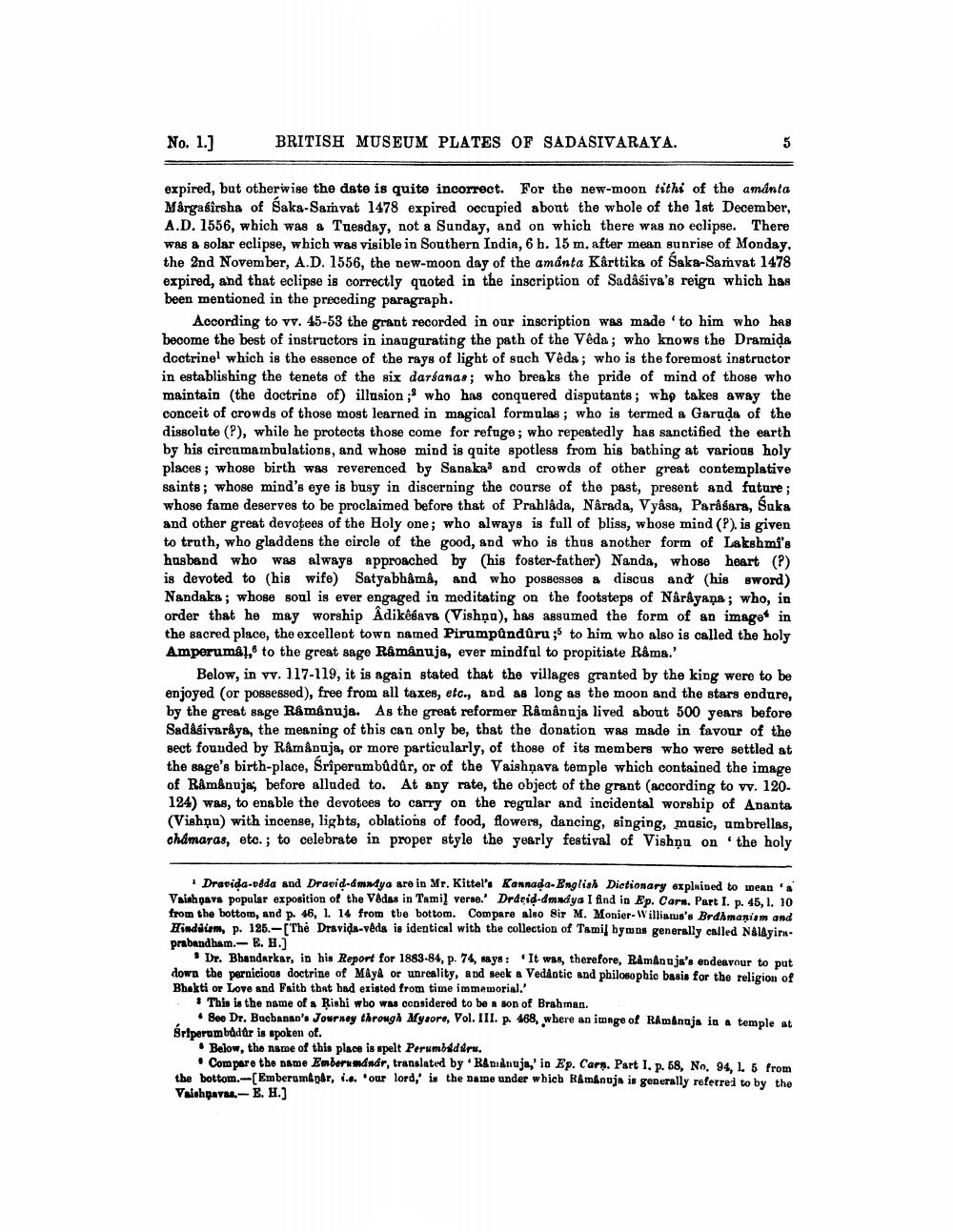________________
No. 1.]
BRITISH MUSEUM PLATES OF SADASIVARAYA.
expired, but otherwise the date is quite incorrect. For the new-moon tithi of the amânta Mårgasirsha of Saka-Samvat 1478 expired occupied abont the whole of the 1st December, A.D. 1556, which was & Tuesday, not a Sunday, and on which there was no eclipse. There Was & solar eclipse, which was visible in Southern India, 6 b. 15 m. after mean sunrise of Monday, the 2nd November, A.D. 1556, the new-moon day of the amanta Karttika of Saka-Samvat 1478 expired, and that eclipse is correctly quoted in the inscription of Sadasiva's reign which has been mentioned in the preceding paragraph.
According to vv. 45-53 the grant recorded in our inscription was made to him who has become the best of instructors in inaugurating the path of the Veda; who knows the Dramida doctrinel which is the essence of the rays of light of such Veda; who is the foremost instructor in establishing the tenets of the six darśanas; who breaks the pride of mind of those who maintain the doctrine of) illusion;' who has conquered disputants; who takes away the conceit of crowds of those most learned in magical formulas; who is termed a Garuda of the dissolute (?), while he protects those come for refuge; who repeatedly has sanctified the earth by his circumambulations, and whose mind is quite spotless from his bathing at various holy places; whose birth was reverenced by Sadaka and crowds of other great contemplative saints; whose mind's eye is busy in discerning the course of the past, present and future ; whose fame deserves to be proclaimed before that of Prahlada, Narada, Vyasa, Parasara, Saka and other great devotees of the Holy one; who always is full of bliss, whose mind (?). is given to truth, who gladdens the circle of the good, and who is thus another form of Lakshmi's husband who was always approached by his foster-father) Nanda, whose heart (?) is devoted to his wife) Satyabhâmâ, and who possesses a discus and his sword) Nandaka; whose soul is ever engaged in meditating on the footsteps of Narayana; who, in order that he may worship Adikeśava (Vishạn), has assumed the form of an image in the sacred place, the excellent town named Pirumpûndûru; to him who also is called the holy Amperumal, to the great sage Râmânuje, ever mindful to propitiate Råma.'
Below, in vv. 117-119, it is again stated that the villages granted by the king were to be enjoyed (or possessed), free from all taxes, etc., and as long as the moon and the stars endure, by the great sage Råmanuja. As the great reformer Ramanuja lived about 500 years before Sadasivaraya, the meaning of this can only be, that the donation was made in favour of the sect founded by Råmånuja, or more particularly, of those of its members who were settled at the sage's birth-place, Sriperumbüdür, or of the Vaishnava temple which contained the image of Råmanuja, before alluded to. At any rate, the object of the grant (according to vv. 120124) was, to enable the devotees to carry on the regular and incidental worship of Ananta (Vishạn) with incense, lights, oblations of food, flowers, dancing, singing, music, umbrellas, chámaras, etc.; to celebrate in proper style the yearly festival of Vishnu on the holy
Dravida-odda and Dravid-dmndya are in Mr. Kittel's Kannada-English Dictionary explained to mean'a Vaishgavs popular exposition of the Vedas in Tamil verse.' Drdeid.dmadya I find in Ep. Carn. Part I. p. 45, l. 10 from the bottom, and p. 46, 1. 14 from the bottom. Compare also Sir M. Monier-Williams's Brahmanism and Hinddiem, p. 125.-[The Dravida veda is identical with the collection of Tamil hymns generally called Nålayiraprabandham.-E. H.]
Dr. Bhandarkar, in his Report for 1883-84, p. 74, says: It was, therefore, Ramanuja's endeavour to put down the pernicious doctrine of Maya or unreality, and seek a Vedantic and philosophic basis for the religion of Bhakti or Love and Faith that had existed from time immemorial.'
* This is the name of Rishi who was ecosidered to be a son of Brahman
See Dr. Bucbanan's Journey through Mysore, Vol. III. p. 468, where an image of Ramanuja in a temple at Śrfperombadar is spoken of.
Below, the name of this place is spelt Perumbidiru.
• Compare the name Emborumdnar, translated by Randnuja,' in Ep. Carn. Part 1. p. 68, No. 94, L 5 from the bottom. (Emberum pår, i... our lord, is the name under which R&mánuja is generally referred to by the Vaishqavas.-E. H.)




